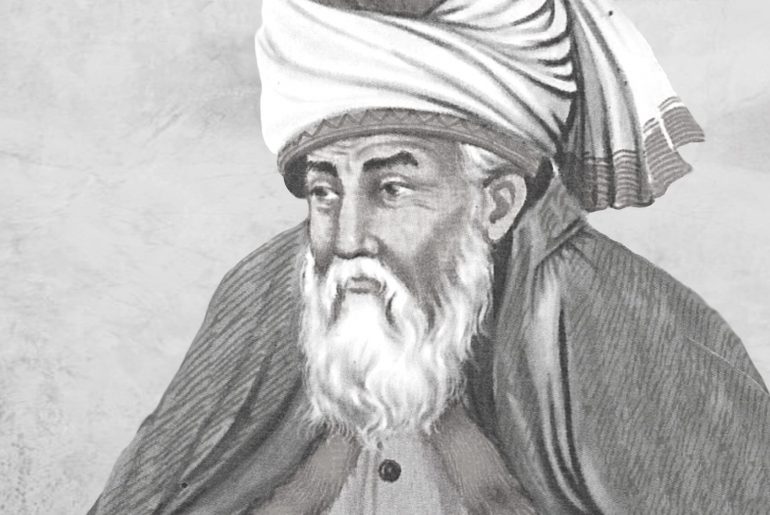Maulana Jalaluddin Rumi was born on September 30, 1207 in Balkh (then Persia, now Afghanistan) and died on December 17, 1273 in Konya (now Turkey). He is considered by many to be “the greatest mystical poet of all time”. At the age of 12 he and his family had to leave Afghanistan to escape from the Mongols. On the long journey via Baghdad to Mecca and Damascus, Rumi was taught by the best Islamic scholars. His father, also a famous scholar with a strong penchant for Sufi mysticism, was called to a chair at the Seljuk seat of government in Konya. When his father died shortly thereafter, Rumi took over his chair at the age of 22.
Rumi was an extremely popular teacher when his life took a dramatic turn in 1244: the wandering dervish Shams from Tabriz crossed his path and became his spiritual teacher and beloved friend. Konya society was shocked, as wandering dervishes did not have a good reputation. For Rumi, Shams was the face of God personified. For his sake, he dropped everything and neglected his duties as a father, teacher and judge. So it came about that jealous students and Rumi’s relatives put pressure on Shams and drove him out. First Rumi managed to find him again, but one day Shams disappeared forever, probably he was murdered by a son of Rumi.
Rumi suffered terribly at this loss, his soul burned in the fire of his love. From then on he wrote poems for Shams and even began to sign them with his name (this is also the name of his most famous collection of poems Diwan – i – Shamsi Tabrizi). More and more he became Shams, overcoming the great illusion of separation and death. From now on, Rumi’s joy knew no bounds. He had realized the Fanafillah – the un-becoming, the Islamic confession of unity.
if you feel
How your lips become infinite
And sweet as the moon in the sky
when you feel this vastness inside you,
Shams of Tabriz is there too.
He had become a finder of God, and twirled in his joy just as Shams had done. Meanwhile, he came up with thousands of poems and stories that ultimately resulted in one of the most important works of world literature (e.g. the so-called Persian Koran: The Mesnevi).
But far beyond his work, Maulana (the master) Rumi is still revered as a saint today. When he died in Konya on December 17, 1273, the celebrations lasted 3 days with music and whirling dance. Members of all religious communities are said to have taken part in the festival. Rumi himself had wished to celebrate his death like a wedding: “…for at God’s feast no sorrow is fitting!”
His tomb in Konya is still an internationally visited place of pilgrimage today. His eternal word is written on his grave:
Come, come, whoever you are!
Come, even if you have broken your promises a thousand times!
Come, come, whether you are a Jew, a Christian, or a Muslim. Come!
About Sufism
Sufism – is not a uniform size and is not bound by external preconditions. Its core, however, is always the same: the knowledge of the absolute Oneness of God, the Only One who has true existence.
Sufism has historically evolved from the religious foundations of Islam, meditation of the Qur’an, and early shamanic tribal cultures. However, Sufism has also become a collective term for movements that no longer have anything to do with its Islamic foundations, as in Europe and North America.
The nickname as-Sufi appears as early as the 8th century AD. Some of the early ascetics wore woolen robes, and after this they were called Sufi (from suf “wool”). The Sufis themselves liked to derive their name from safa, “purity”: the sufi is the safi, the purified, the chosen.
The element of pure, joyful love of God was introduced into this austere ascetic world by a woman, Rabi’a (d. 801). She spoke for the first time of absolute love, which turns directly to God without thinking of fear of hell or hope for paradise. Rabi’a’s thoughts deeply influenced the following generations. The love between God and man was expressed in ever finer terms by the Sufi masters, although they knew that “there is nothing more subtle than love, and since concepts can only be expressed in terms of something more subtle than the concept one cannot express love.” (Sumnun the Lover, c.900)
The language in which Sufi thoughts have been most poetically expressed is Persian, with its profuse literature. The Turks took over the inheritance and continued literary activity on various levels – folk poetry is particularly attractive. We also find the same phenomena on the Indian subcontinent – here not only as an Arabic-Persian component. Rather, the Sufi thoughts are pronounced in the regional languages. So the seals in Sindhi, Punjabi, Siraiki, Kashmiri, Gujarati, Bengali, or Pashto, as well as the classic Urdu; even in Tamil there is Sufi-influenced poetry. The same applies to Africa (Swahili).
Jonathan Star, the American translator Rumis, describes Sufism as an undogmatic “way of love”:
“The Sufis seek the hidden mysteries of life; it craves them for direct experience of God, whom they call the “beloved.” They do not see in him a stern master or an unattainable absolute, but someone to be approached with perfect love… This fearless love of God made the Sufis dance and sing and party all night long. “Normal” people often saw them as crazy – but at the same time they were respected as great artists, poets, and mystics of Islam…”
What does Rumi say about love?
Sow the love of the saints within your spirit; do not give your heart to anything, except to the love of those with cheerful hearts. We must love those who bring us more happiness to our lives, those who add positively with their own love for us.
Who was Rumi in Spanish?
The youngest man was 37 years old and his name was Djalâl al-dîn Mohammad Balkhî or Rûmî. In Turkey he is now known simply by the title Mevlânâ, meaning “our master” or “our lord”, and in the West by the name Rumi, referring to the Seljuk sultanate of Rûm, of which Konya was the capital.
Where did Jalal ad Din Muhammad Rumi die?
Iconium is a Turkish city in the Central Anatolia region, capital of the homonymous province. It has 1,304,209 inhabitants.
Who invented the Rumi?
The original game was created in the 1940s by Ephraim Hertzano, a Romanian inventor, who later emigrated to Israel.
When was Rumi born?
Full name: Jalāl ad-Dīn Muhammad Balkhī
Place of birth: Balkh, Afghanistan
What was Rumi like?
Muslim mystic poet from Persia, whose full name is Jalal al-Din Rumi. Although he was born in Balkh (Korasan), his life was linked to the city of Iconium (now Konya), in Turkey.
What is Sufism?
Sufism is spiritual courtesy (adab): courtesy with every instant, in all circumstances and at all times.



